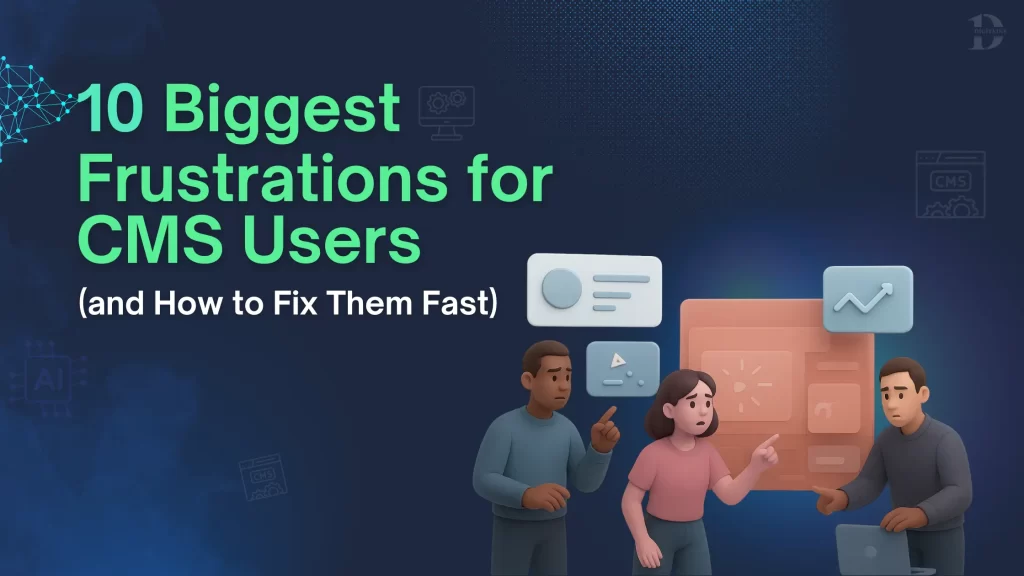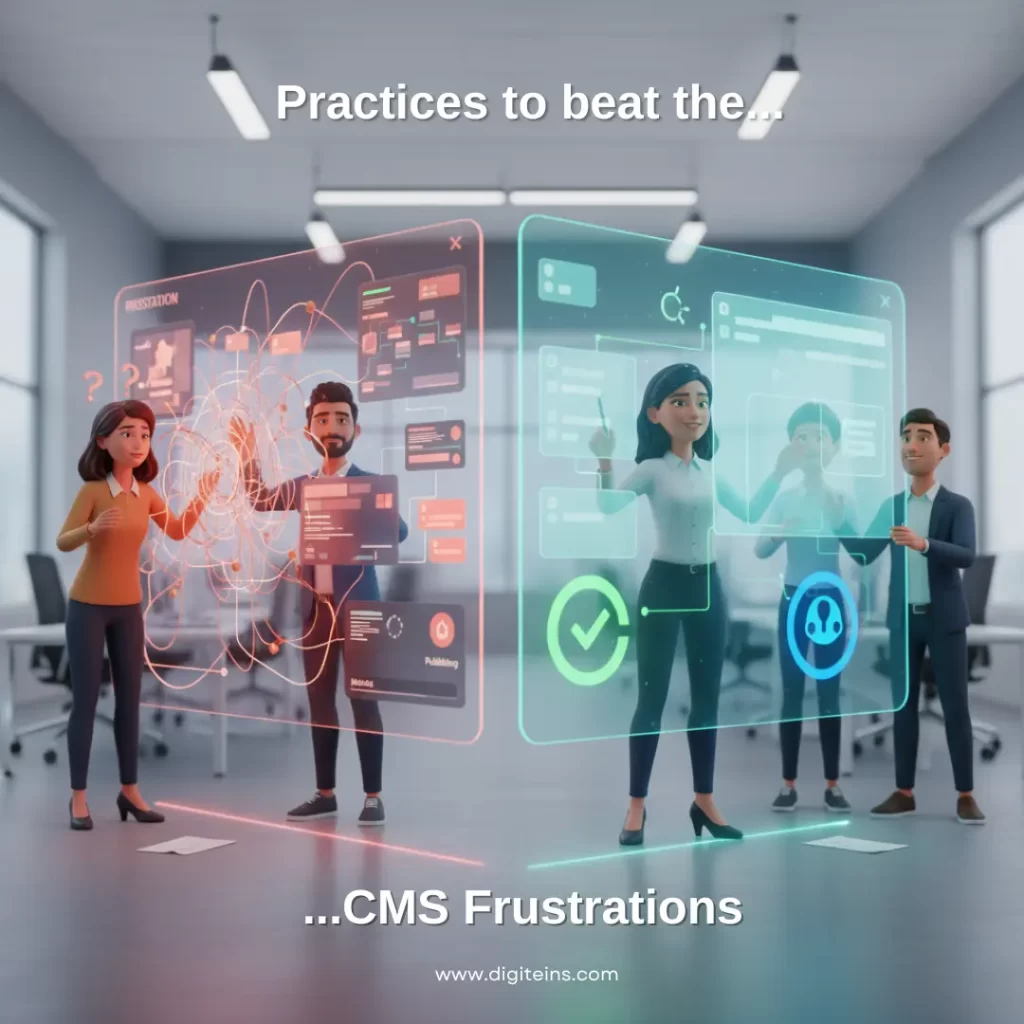Since the modern world is digital, a content management system (CMS) is necessary to enable businesses to create, manage, and publish content without having to possess comprehensive technical expertise.
It is convenient and efficient on popular platforms, such as Sitecore, WordPress, Contentful, Drupal, Joomla, Shopify, AEM, and Optimizely, but users are repeatedly fed the same frustration: cumbersome interface, low scalability, and other issues, leaving many teams with no choice but to remain stuck on their technology.
It is important to learn about the most typical CMS frustrations. It enhances user satisfaction, productivity, digital performance, and long-term growth.

What Is a CMS and Why Businesses Rely on It?
A CMS (Content Management System) refers to software that can be used by individuals and organizations to build, maintain, and publish digital content without the requirement of knowing advanced code programming languages.
The most popular ones are Sitecore, Contentful, WordPress, AEM, Optimizely, Contentstack, Drupal, Joomla, Wix, and Shopify, which offer templates, plugins, and tools to manage a website.
This is due to the fact that businesses depend on CMS platforms, which:
- Make content creation and publishing easy.
- Facilitate teamwork.
- Less developer reliance.
- Scalable support for increased websites.
However, regardless of these benefits, users mostly face frustrations that prevent productivity and growth.
The Biggest Frustrations for CMS Users
We shall examine the top ten frustrations as reported worldwide.
1. Complex User Interface and bad Usability
Badly organized dashboards, incoherent menus, and non-user-friendly navigation drown numerous users of CMS, particularly novices, and waste their time and learning curve.
2. Poor Customizability
Not every platform allows such extreme customization.
Fixed templates, lack of design options, or expensive value-added packages can be restrictive to users.
3. Performance and Loading Speed Problems
Slow websites are annoying and damaging to search engines.
Speed is a common problem as a result of CMS bloat, unnecessary use of plugins, and old themes.
4. Security Vulnerability and Threats
The targets of hackers are CMS sites. They can be exposed to malware, phishing, and ransomware without being updated regularly.
5. Integration Problems with Other Tools
Most business entities depend on the use of CRMs, analytics, and e-commerce applications, and the problem with these CMSs is that they fail to integrate effectively, making them inefficient.
6. Lack of Customer Support and Documentation
Delayed support, vague documentation, and unclear guides are frequent complaints by the users, who are left to figure it out on their own, and with technical problems.
7. Expensive Upkeep and Operating Charges
Though most of the platforms seem cheap, expenses are accrued in the form of fancy themes, plugins, hosting, and third-party services.
8. Inability to Scale up Businesses
A CMS that performs well on a small blog could break down when stressed by a high amount of traffic or an advanced e-commerce situation. Scalability is a big issue.
9. Issues of Content Collaboration
Traditional CMS setups provide limited real-time editing, version control, and approval workflow to large teams.
10. Learning curve of Non-Technical users is steep.
Also, in spite of being said to be user-friendly, most CMSs still need a basic knowledge of custom coding, which infuriates non-technical users.

Best Practices to beat the CMS Frustrations
It is good because there is a way out of most of these problems. Through informed decisions, businesses are able to convert frustrations to opportunities.
How to select the suitable CMS for your business needs
Not all platforms are equal. You should consider the following before committing:
- State your objectives- blogging, e-commerce, or enterprise content.
- Compare integrations, scalability, and ease of use.
- Try out the free versions or demos.
WordPress offers flexibility for blogs and small businesses, while Shopify excels at e-commerce. Sitecore and Contentful support enterprise-level CMS needs.
Periodic Updates, Maintenance, and Security Activities
Maintaining your CMS is a security measure.
Follow these best practices:
- Keep the core CMS, themes, and plugins updated.
- Back up data weekly.
- Make use of firewalls, malware checks, and SSL certificates.
These measures prevent hacks, downtime, and loss of data.
Taking advantage of Third-party Plugins and Integrations
It will allow you to extend your CMS with plugins and APIs instead of recreating the wheel:
- SEO plugins—Yoast, Rank Math
- E-commerce extensions -WooCommerce, Shopify applications.
- The integration of analytics, Google Analytics, and HubSpot.
Team Member Training and Support
The finest CMS can be useless when the team is not familiar with it.
Businesses should:
- Provide employee training.
- Develop some internal workflow documentation.
- Consult CMS forums and professional consultants in order to troubleshoot.
Effective Ways to Address CMS Frustrations
The positive thing is that the majority of the CMS frustrations are manageable with preventive measures. The initial one is to select the appropriate CMS for the needs of the business.
WordPress continues to be a terrific option when flexibility is needed and small businesses, while Shopify is the best option when e-commerce is required, Sitecore and Contentful are suitable when businesses need to achieve personalization and marketing automation and headless-omnichannel publishing, respectively.
It is also important to update and maintain regularly. By ensuring that CMS cores, plugins, and themes are maintained in that way, businesses can go a long way in minimizing security risks. Reliability is further increased by strong hosting, backups, and security, including SSL certificates and firewalls.
Integrations and plugins can also be used to overcome limitations. One such example is that SEO, a WordPress plug-in, or an API-based relationship in Contentful can be extended. They must, however, be chosen carefully to avoid performance hitches.
Finally, training the team is essential to make sure that personnel members make efficient use of the CMS.
A lot of frustrations are not related to the platform but to the lack of knowledge regarding the use of the platform itself. Comprehensive training and clear internal documentation can save time and prevent costly errors.
Trends to monitor the Future of CMS Platforms.
- AI & Automation- intelligent SEO and intelligent workflows.
- Headless CMS Growth- Contentful and other platforms are on top.
- Sitecore Enterprise CMS becomes an AI-based digital experience platform (DXP).
Recommendation: CMS Frustrations Into Opportunities
WordPress to Sitecore, Contentful, and each of the known CMSs has its strong and weak points. The most common disappointments are the usability, scalability, cost, and performance problems. It might appear that these issues are insurmountable, but they can be conquered. The right choice of the platform, its maintenance, and the right integrations, as well as staff training, may aid in turning CMS challenges into growth prospects.
There is no need to work your way through the CMS scenery. Digiteins has the capability of taking the burden of selecting, deploying, and adopting the appropriate CMS.
Both in terms of flexibility (WordPress), the power of an enterprise (Sitecore), or the ability to access any channel (Contentful), Digiteins will help you find the ideal solution to your business requirements.



